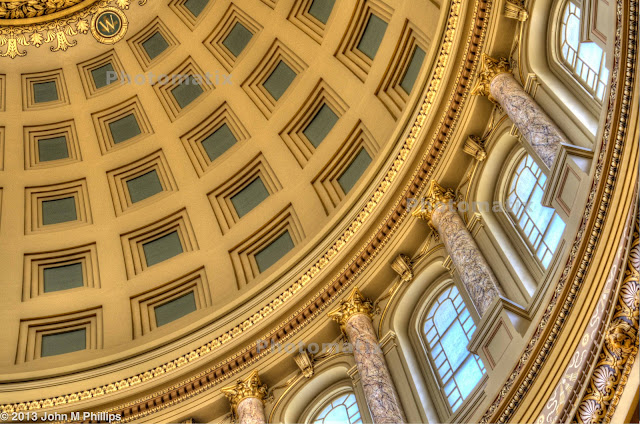Here is one of the photos that I took--in this case a single shot that I modified in post processing.
And here are two HDR renditions.
Admittedly, I spent some time in post processing modifying the first (normal) image, but frankly I think it has a more dynamic quality than either of the HDR versions. And there is quite a bit of work involved in creating the blended HDR image, even though Photomatrix streamlines the process as much as possible.
Here's another example. First, the "normal" shot.
And now the HDR version.
Again, not much difference, and the standard shot seems to have more depth to it.
Here is another image, this time of a portion of the central dome. (I like this shot quite a lot.)
Here is a fairly normal looking HDR version.
Frankly, not much difference. Here are a couple of other HDR versions that represent greater departures from "normality."
Another example. Again, first the normal shot.
Here is an HDR version.
There is an interesting quality to the "golden" color of the primary arch in the above shot, and the colors generally are quite a bit brighter. (Not sure why the above image did not include the Photomatrix watermarks.) Here are a couple more extreme versions.
There might be a place for a shot such as the above in special circumstances but not in my portfolio.
Here is another example: Standard . . .
and HDR.
I would admit that this last image has an attention-getting quality, even if the colors are garish and not realistic.
One final example. Normal . . .
and HDR.
The first HDR image is fairly realistic but doesn't offer anything beyond the standard shot. The latter HDR image seems dark.
In each of these examples, as I stated, I had spent some time modifying the standard image. But in all the cases I tried, the "tame" versions of HDR didn't seem to add anything to the version I could create with normal post processing. And in most cases the more unusual versions came across as too extreme and cartoonish for my tastes.
I will do some more experimenting, but at this point I am not willing to pay for any HDR software.



















sure can see a difference between "norman" and the "HDR."
ReplyDelete